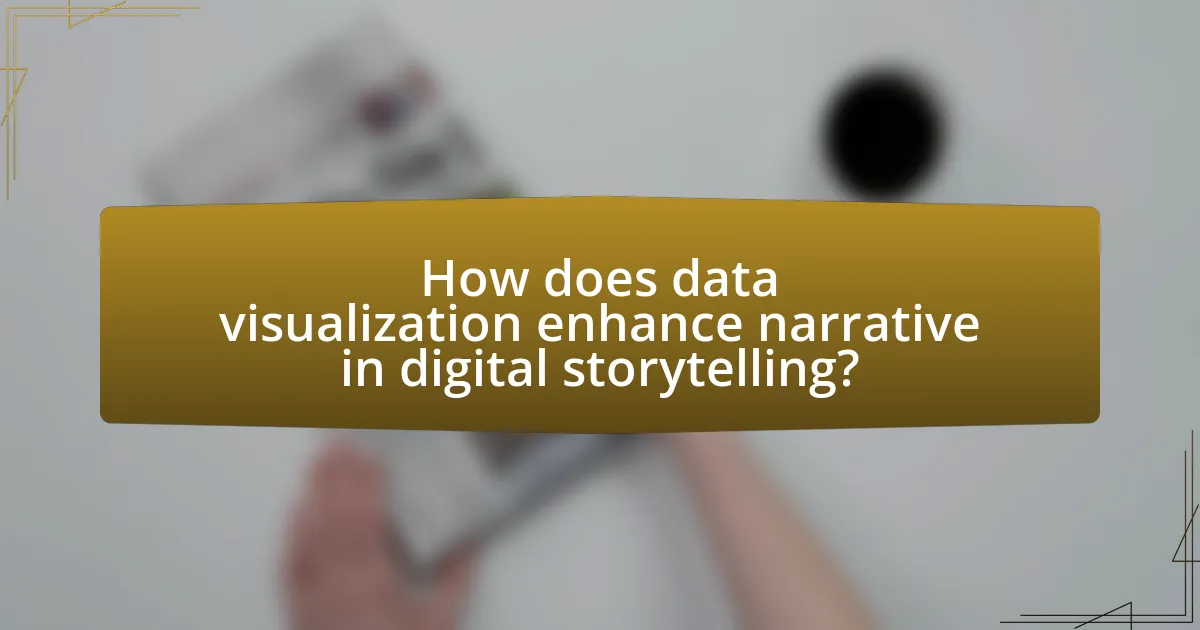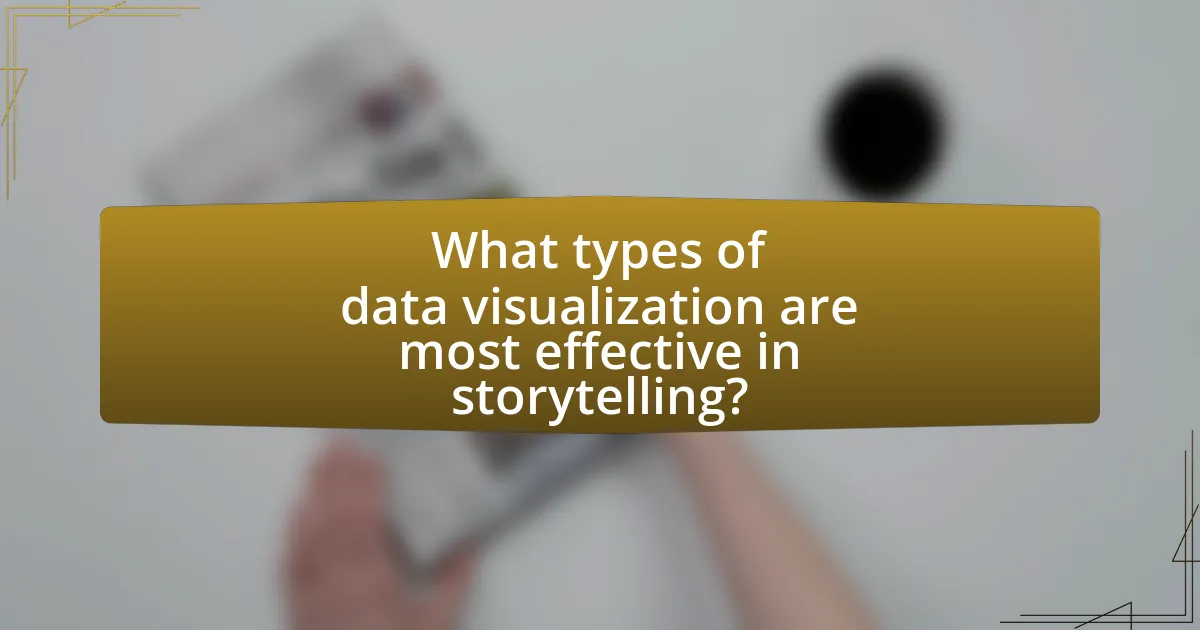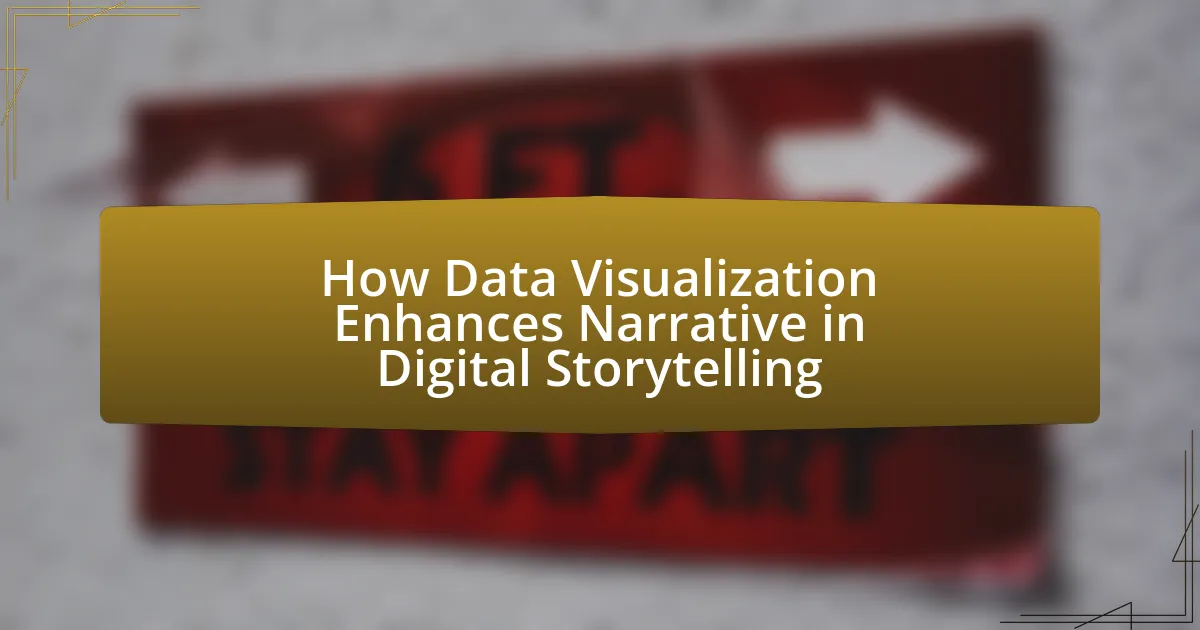Data visualization significantly enhances narrative in digital storytelling by converting complex data into accessible visual formats, facilitating better understanding and engagement. It allows audiences to quickly grasp key insights, patterns, and trends, which can evoke emotional responses and improve information retention by up to 65%. Effective types of data visualization, such as charts, graphs, and infographics, play a crucial role in simplifying information and enriching narratives. Best practices for integrating data visualization include ensuring clarity, relevance, and engagement, while common mistakes to avoid involve overloading visuals and using inappropriate chart types. Overall, data visualization serves as a powerful tool in crafting compelling digital narratives.

How does data visualization enhance narrative in digital storytelling?
Data visualization enhances narrative in digital storytelling by transforming complex data into visual formats that are easier to understand and interpret. This visual representation allows audiences to grasp key insights quickly, making the narrative more engaging and impactful. For instance, studies show that visuals can increase information retention by up to 65%, as they facilitate cognitive processing and emotional connection. By integrating charts, graphs, and infographics, storytellers can highlight trends and patterns that support the narrative, thereby enriching the overall storytelling experience.
What role does data visualization play in storytelling?
Data visualization plays a crucial role in storytelling by transforming complex data into accessible visual formats that enhance understanding and engagement. By presenting information visually, data visualization allows audiences to grasp patterns, trends, and insights quickly, which can evoke emotional responses and facilitate deeper connections with the narrative. For instance, studies show that visuals can increase information retention by up to 65%, making data-driven stories more impactful and memorable.
How does data visualization simplify complex information?
Data visualization simplifies complex information by transforming intricate datasets into visual formats that are easier to interpret and understand. This process allows users to quickly grasp patterns, trends, and insights that may be obscured in raw data. For instance, studies show that people can process visual information 60,000 times faster than text, highlighting the efficiency of visual representation in conveying complex ideas. By using charts, graphs, and maps, data visualization distills large volumes of information into digestible visuals, enabling clearer communication and better decision-making.
What emotional responses can data visualization evoke in audiences?
Data visualization can evoke a range of emotional responses in audiences, including surprise, empathy, and engagement. These emotional reactions occur because visual representations of data can simplify complex information, making it more relatable and impactful. For instance, a study by the Nielsen Norman Group found that users are more likely to remember information presented visually compared to text, which can lead to stronger emotional connections. Additionally, visualizations that highlight disparities or trends can foster empathy by illustrating real-world issues, such as income inequality or climate change, prompting audiences to feel a sense of urgency or concern.
Why is data visualization important for digital narratives?
Data visualization is important for digital narratives because it transforms complex data into accessible visual formats, enhancing comprehension and engagement. By presenting information visually, narratives can convey insights quickly and effectively, allowing audiences to grasp key messages without extensive textual explanations. Research indicates that visuals can improve information retention by up to 65%, demonstrating their effectiveness in storytelling. Furthermore, data visualization can highlight trends and patterns that may not be immediately apparent in raw data, thereby enriching the narrative and providing a deeper understanding of the subject matter.
How does it improve audience engagement?
Data visualization improves audience engagement by transforming complex data into visually appealing and easily digestible formats. This visual representation captures attention more effectively than text alone, as studies show that visuals are processed 60,000 times faster by the brain compared to text. Furthermore, engaging visuals can evoke emotional responses, making the narrative more relatable and memorable. For instance, research published in the journal “Computers in Human Behavior” indicates that interactive data visualizations significantly increase user engagement and retention of information.
What are the cognitive benefits of using data visualization in storytelling?
Data visualization in storytelling enhances cognitive processing by improving comprehension, retention, and engagement. Visual representations of data allow individuals to quickly grasp complex information, as studies show that visuals are processed 60,000 times faster than text. This rapid processing aids in identifying patterns and trends, which enhances understanding. Furthermore, research indicates that people remember 80% of what they see and do, compared to only 20% of what they read and 10% of what they hear. Thus, integrating data visualization into narratives not only makes the information more accessible but also significantly boosts memory retention and engagement levels among audiences.

What types of data visualization are most effective in storytelling?
Effective types of data visualization in storytelling include bar charts, line graphs, and infographics. Bar charts effectively compare quantities across categories, making differences clear and easy to interpret. Line graphs illustrate trends over time, allowing audiences to grasp changes and patterns quickly. Infographics combine visuals and text to present complex information in an engaging and digestible format, enhancing understanding and retention. Research by the Nielsen Norman Group indicates that visual information is processed 60,000 times faster than text, underscoring the importance of these visualization types in effective storytelling.
How do different visualization types impact narrative delivery?
Different visualization types significantly impact narrative delivery by influencing how information is perceived and understood. For instance, charts and graphs can simplify complex data, making it easier for audiences to grasp key trends and relationships, while infographics combine visuals and text to create a more engaging storytelling experience. Research by Ware (2013) in “Information Visualization: Perception for Design” demonstrates that visual elements can enhance memory retention and comprehension, indicating that effective visualization can lead to a more impactful narrative. Additionally, interactive visualizations allow users to explore data at their own pace, fostering deeper engagement and personal connection to the narrative.
What are the advantages of using infographics in digital storytelling?
Infographics enhance digital storytelling by simplifying complex information, making it more accessible and engaging for audiences. They visually represent data, which aids in comprehension and retention; studies show that visuals can increase information retention by up to 65%. Additionally, infographics can convey messages quickly, as they allow viewers to grasp key points at a glance, thus improving the overall effectiveness of the narrative. By integrating visual elements with textual content, infographics create a more immersive experience, fostering emotional connections and encouraging audience interaction.
How do charts and graphs enhance understanding of data?
Charts and graphs enhance understanding of data by visually representing complex information, making it easier to identify patterns, trends, and relationships. For instance, a line graph can illustrate changes over time, allowing viewers to quickly grasp fluctuations in data points. Research shows that visual information is processed 60,000 times faster than text, which underscores the effectiveness of visual aids in communication. Additionally, studies indicate that people retain 65% of information presented visually compared to only 10% when presented in text form. This demonstrates that charts and graphs not only simplify data interpretation but also improve retention and comprehension, making them essential tools in digital storytelling.
What are the best practices for integrating data visualization into narratives?
The best practices for integrating data visualization into narratives include ensuring clarity, relevance, and engagement. Clarity is achieved by using simple and intuitive visual formats that accurately represent the data, making it easy for the audience to understand the key messages. Relevance involves selecting visualizations that directly support the narrative, enhancing the story rather than distracting from it. Engagement can be fostered by incorporating interactive elements that allow the audience to explore the data further, thereby deepening their connection to the narrative. Research by Few (2009) emphasizes that effective data visualization should complement the storytelling process, making complex information accessible and compelling.
How can one choose the right type of visualization for their story?
To choose the right type of visualization for a story, one must first identify the key message and the data that supports it. Different types of visualizations, such as bar charts, line graphs, or infographics, serve distinct purposes; for instance, bar charts effectively compare quantities, while line graphs illustrate trends over time. Research indicates that the choice of visualization can significantly impact audience comprehension and engagement, as demonstrated by a study published in the journal “Information Visualization,” which found that well-chosen visual formats can enhance retention of information by up to 65%. Therefore, aligning the visualization type with the narrative’s objective and the nature of the data is crucial for effective storytelling.
What common mistakes should be avoided when using data visualization?
Common mistakes to avoid when using data visualization include overloading visuals with excessive information, which can confuse the audience. Simplifying data presentation enhances clarity and comprehension. Additionally, using inappropriate chart types can misrepresent data; for example, a pie chart is ineffective for displaying changes over time. Ensuring the correct visualization type aligns with the data’s nature is crucial. Another mistake is neglecting color choices, as poor color contrast can hinder readability. Research indicates that 8% of men and 0.5% of women are colorblind, making it essential to use color palettes that are accessible to all viewers. Lastly, failing to provide context or labels can lead to misinterpretation; clear titles and annotations guide the audience in understanding the data’s significance.

How can data visualization be used to tell compelling stories?
Data visualization can be used to tell compelling stories by transforming complex data into visual formats that are easily understandable and engaging. This approach allows audiences to grasp insights quickly, as visuals can highlight trends, patterns, and correlations that might be overlooked in textual data. For instance, a study by the Data Visualization Society found that people retain 65% of information presented visually compared to only 10% when presented in text. By using charts, graphs, and infographics, data visualization not only simplifies information but also evokes emotional responses, making the narrative more relatable and impactful.
What techniques can enhance the narrative through data visualization?
Techniques that can enhance the narrative through data visualization include the use of storytelling frameworks, interactive elements, and effective design principles. Storytelling frameworks, such as the narrative arc, help structure data in a way that guides the audience through a coherent story, making complex information more relatable. Interactive elements, like filters and tooltips, engage users by allowing them to explore data at their own pace, fostering a deeper understanding. Effective design principles, including color theory and typography, improve readability and focus attention on key insights, ensuring that the visual narrative resonates with the audience. Research by Few (2012) in “Show Me the Numbers” emphasizes that well-designed visualizations can significantly enhance comprehension and retention of information, validating the importance of these techniques in data storytelling.
How can storytelling elements be combined with data visualization?
Storytelling elements can be combined with data visualization by integrating narrative structures, emotional engagement, and visual metaphors to enhance understanding and retention of information. For instance, using a clear narrative arc—such as a beginning, middle, and end—can guide viewers through complex data, making it more relatable. Emotional engagement can be achieved by selecting visuals that resonate with the audience, such as using color schemes that evoke specific feelings or incorporating human stories behind the data. Visual metaphors, like using a tree to represent growth data, can simplify complex concepts and make them more accessible. Research shows that narratives can improve memory retention by up to 65%, demonstrating the effectiveness of this approach in data storytelling.
What are some successful examples of data-driven storytelling?
Successful examples of data-driven storytelling include The New York Times’ “Snow Fall,” which combines immersive visuals with data to narrate the story of an avalanche, and the “Human Development Index” by the United Nations, which uses statistical data to illustrate global development trends. “Snow Fall” garnered significant attention for its innovative use of multimedia elements, resulting in over 3 million page views in its first week. The “Human Development Index” effectively communicates complex data through visualizations, influencing policy discussions and development strategies worldwide. These examples demonstrate how data can enhance narrative depth and engage audiences effectively.
What tools and resources are available for creating data visualizations?
Numerous tools and resources are available for creating data visualizations, including software and online platforms. Popular tools include Tableau, which allows users to create interactive and shareable dashboards; Microsoft Power BI, known for its integration with other Microsoft products; and Google Data Studio, which offers free data visualization capabilities with easy sharing options. Additionally, programming languages like Python and R provide libraries such as Matplotlib, Seaborn, and ggplot2 for custom visualizations. These tools are widely used in various industries, demonstrating their effectiveness in enhancing narrative through visual storytelling by making complex data more accessible and engaging.
Which software options are best for beginners in data visualization?
Tableau, Microsoft Power BI, and Google Data Studio are the best software options for beginners in data visualization. Tableau offers a user-friendly interface and a wide range of visualization options, making it accessible for those new to data analysis. Microsoft Power BI integrates seamlessly with other Microsoft products and provides intuitive drag-and-drop features, which simplifies the creation of reports and dashboards. Google Data Studio is free and allows users to create interactive reports easily, making it an excellent choice for beginners. These tools are widely recognized for their ease of use and supportive online communities, which provide resources and tutorials for new users.
How can one access quality data for visualization purposes?
One can access quality data for visualization purposes by utilizing reputable data repositories and platforms that provide verified datasets. Sources such as the World Bank, Kaggle, and government databases like data.gov offer extensive collections of high-quality data across various domains. These platforms ensure data accuracy and reliability, often accompanied by metadata that describes the dataset’s origin and methodology. For instance, the World Bank provides economic and social data that is widely used in research and analysis, ensuring that users can create visualizations based on credible information.
What are practical tips for effective data visualization in storytelling?
Effective data visualization in storytelling requires clarity, relevance, and engagement. To achieve clarity, use simple and intuitive designs that highlight key data points, ensuring that the audience can easily interpret the information. Relevance is crucial; select data that directly supports the narrative and resonates with the audience’s interests or needs. Engagement can be enhanced by incorporating interactive elements, allowing users to explore the data themselves, which fosters a deeper connection to the story being told. Research indicates that visuals can improve comprehension by up to 400%, demonstrating the importance of effective data visualization in enhancing narrative impact.

Leave a Reply